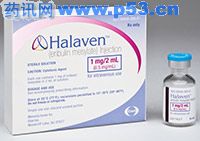|
制造商: 药理分类: 活性成分(补): 药理作用: Eribulin没有显着代谢,主要是消除粪便不变。 临床试验: 法律分类: 成人: 儿童: 警告/注意事项: 互动(补): 不良反应(补): 注释: 如何提供: 最后更新: Manufacturer:Eisai Pharmaceuticals Pharmacological Class:Antineoplastic agent (non-taxane microtubule dynamics inhibitor). Active Ingredient(s):Eribulin mesylate 0.5mg/mL, solution for IV injection. Indication(s):Treatment of metastatic breast cancer in patients who have previously received at least two chemotherapeutic regimens for metastatic disease. Prior therapy should have included an anthracycline and a taxane in either the adjuvant or metastatic setting. Pharmacology:Eribulin mesylate is a synthetic analogue of a substance found in Halichondria okadai, a marine sponge. It is a non-taxane microtubule dynamics inhibitor that inhibits the growth phase of microtubules without affecting the shortening phase. It also sequesters tubulin into nonproductive aggregates. Its tubulin-based antimitotic mechanism leads to G2/M cell-cycle block, disruption of mitotic spindles and, ultimately, apoptotic cell death after prolonged mitotic blockage. Eribulin is not significantly metabolized and is primarily eliminated unchanged in the feces. Clinical Trials:Study 1 compared eribulin and single-agent therapy in an open-label, randomized, multicenter trial involving 762 patients with metastatic breast cancer who had received at least two chemotherapeutic regimens for metastatic disease and had disease progression within 6 months of their last chemotherapy regimen. Randomization was stratified geographically, by HER2/neu status and prior capecitabine exposure. The control group received either 97% chemotherapy (eg, 26% vinorelbine, 18% gemcitabine, 18% capecitabine, 16% taxane, 9% anthracycline, 10% other chemotherapy) or 3% hormonal therapy. The main efficacy outcome was overall survival. A statistically significant improvement in overall survival was seen in the patients given eribulin (13.1 months) compared with the control group (10.6 months). Legal Classification:Rx Adults:Give by IV injection over 2–5 minutes. 1.4mg/m2 on Days 1 and 8 of a 21-day cycle. Mild hepatic impairment (Child-Pugh A) or moderate renal impairment (CrCl 30–50mL/min): 1.1mg/m2 on Days 1 and 8 of a 21-day cycle. Moderate hepatic impairment (Child-Pugh B): 0.7mg/m2 on Days 1 and 8 of a 21-day cycle. Hold dose for ANC <1000/mm3, platelets <75000/mm3, or grade 3 or 4 non-hematological toxicities. Delay or reduce dose according to toxicities; see literature. Do not re-escalate dose after it is reduced. Children:<18 years: not recommended. Warnings/Precautions:Monitor CBCs; increase frequency of monitoring if grade 3 or 4 cytopenias develop, delay and reduce subsequent doses if febrile neutropenia or grade 4 neutropenia lasting >7 days develops. Monitor for peripheral neuropathy; withhold dose if grade 3 or 4 peripheral neuropathy develops until resolution to grade 2 or less. Congenital long QT syndrome: avoid. CHF, bradyarrhythmias, electrolyte abnormalities: monitor ECG for prolonged QT interval. Correct electrolyte abnormalities (K+, Mg+) before treatment; monitor. Severe hepatic impairment (Child-Pugh C) or severe renal impairment (CrCl<30mL/min): insufficient data. Pregnancy (Cat.D), nursing mothers: not recommended. Interaction(s):Caution with other drugs that prolong QT interval (eg, Class IA and III antiarrhythmics); monitor. Adverse Reaction(s):Neutropenia, anemia, asthenia/fatigue, alopecia, peripheral neuropathy, nausea, constipation, febrile neutropenia; possible QT prolongation, elevated liver enzymes. Notes:Do not mix with dextrose-containing solutions. Do not administer in same line as other drugs or fluids. How Supplied:Single-use vial (2mL)—1 |
甲磺酸艾日布林注射剂|Halaven(eribulin mesylate)简介:
制造商: 卫材制药
药理分类: 抗肿瘤剂(非紫杉烷类抑制剂微管的动态)。
活性成分(补): Eribulin甲磺酸为0.5mg/ml,静脉注射解决方案 指示(补): 治疗对谁曾接受至少两个转移性疾病患者化疗 ... 关键字:甲磺酸艾日布林注射剂
责任编辑:admin
|
最新文章更多
推荐文章更多
热点文章更多 |


